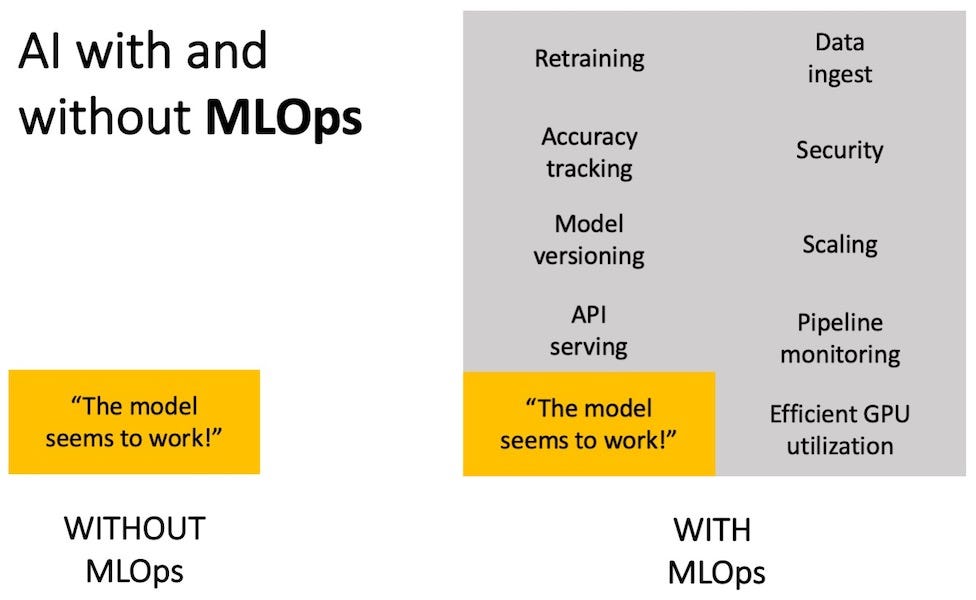ai 模型 是指什么_为什么AI模型很少能投入生产
ai 模型 是指什么
Joint post with Tony Paikeday from NVIDIA.
NVIDIA与Tony Paikeday的联合帖子。
问题:ML模型很难交付 (Problem: ML models are hard to ship)
After making artificial intelligence investments, many teams have found the ROI to be elusive. Often, great experiments fail to become great products. That pain is summed up nicely in this tweet:
在进行了人工智能投资之后,许多团队发现ROI难以捉摸。 通常,出色的实验无法成为出色的产品。 此推文很好地总结了这种痛苦:

https://twitter.com/ginablaber https://twitter.com/ginablaber
After all the sweat equity invested in developing models with high predictive accuracy, it’s painful to see businesses fall into “model debt” with un-deployed or under-deployed models. More often than not, what’s missing is an “MLOps” strategy that unifies machine learning development and IT best practices. Let’s look at why.
在所有汗水投资于开发具有高预测准确性的模型之后,看到企业陷入未部署或部署不足的模型的“模型债务”之苦。 通常,缺少的是一种将机器学习开发和IT最佳实践相结合的“ MLOps ”策略。 让我们看看为什么。
为什么将ML模型投入生产如此困难? (Why is getting ML models into production so difficult?)
Two main reasons:
两个主要原因:
- Teams don’t implement the same DevOps rigor for data science projects as they do for more traditional dev projects. Like other production products, production AI pipelines**** should have monitoring, versioning, scalability, & repeatability. Organizations should budget for IT teams to implement this same level of resilience and repeatability for AI projects.
团队 对数据科学项目的实施与对传统开发项目的实施不同。 与其他生产产品一样,生产AI管道 **** 应该具有监视,版本控制,可伸缩性和可重复性。 组织应为IT团队进行预算,以实现AI项目相同水平的弹性和可重复性。
- AI models are not like conventional software. Model performance can degrade rapidly after the code has shipped. Continuous monitoring and retraining are required, and the related tools are still largely immature — due largely to the fact that best practices are still constantly evolving. Organizations should at least plan for continued data scientist involvement even after models are in production.
AI模型与传统软件不同。 代码交付后,模型性能可能会Swift下降。 需要进行持续的监视和再培训,并且相关工具在很大程度上仍不成熟-这主要是因为最佳实践仍在不断发展。 即使模型已经投入生产,组织也至少应该计划让数据科学家继续参与。

The unplanned steps to get to Production 计划外的生产步骤
如何规划成功 (How to plan for success)
PEOPLE: Bring IT and data science teams together
人员:将IT和数据科学团队整合在一起
A lot of AI work is opaque — not everybody can easily inspect or understand it. The people who build it are basically considered artisans. So, organizations often perceive that the responsibility for these projects lies solely with data science teams. This is short-sighted.
许多AI工作是不透明的-并非每个人都可以轻松地检查或理解它。 建造它的人基本上被认为是工匠。 因此,组织通常会认为这些项目的责任完全在于数据科学团队。 这是短视的。
AI projects need to be integrated into the enterprise IT operation. AI developers often aren’t–and probably shouldn’t–be experts in how to build sturdy, scalable platforms.
AI项目需要集成到企业IT运营中。 AI开发人员通常(而且可能不应该)是如何构建坚固,可扩展的平台的专家。
And it’s a two-way street: both sides of the house need to plan for each other’s work. Do your data scientists build robust models? Do they have a scalable design for inference? Can your IT team support ad-hoc infrastructure requests? Do they provide self-service environments to developers? Maybe you need an “AI Engineer” role?
这是一条双向的街道:房子的两边都需要为彼此的工作做计划。 您的数据科学家会建立健全的模型吗? 他们有可扩展的推理设计吗? 您的IT团队可以支持临时基础结构请求吗? 他们是否向开发人员提供自助服务环境? 也许您需要一个“ AI工程师”角色?
PROCESS: Implement a Design → Test → Production process for AI projects
过程:为AI项目实施设计→测试→生产过程
Today, many companies haven’t implemented lifecycle management for their AI projects. Like with any product, having a defined release cycle standardizes the process. Having a little bit of process actually makes it easier for individual projects to get out the door since they don’t have to reinvent the wheel each time.
如今,许多公司尚未为其AI项目实施生命周期管理。 像任何产品一样,具有定义的发布周期可以标准化流程。 实际上,有了一点点流程就可以使单个项目更轻松地完成任务,因为它们不必每次都重新发明轮子。
Expect for the process to evolve and grow — that’s a good sign that you’re using the system. But you have to start somewhere.
期望流程不断发展和壮大-这是您正在使用系统的好兆头。 但是你必须从某个地方开始。
TECHNOLOGY: Plan for rapidly evolving technology
技术:规划快速发展的技术
For traditional software development workflows, modern devops tools are constantly evolving. But for AI development, the tools are evolving even more rapidly as the application ecosystem rushes fill tooling gaps. Planning for evolving MLOps applications requires flexible infrastructure and a willingness to keep researching the latest schedulers, versioning tools, experiment trackers, ….
对于传统的软件开发工作流程,现代的devops工具正在不断发展。 但是对于AI开发而言,随着应用程序生态系统急于填补工具空白,这些工具的发展甚至更加Swift。 规划不断发展的MLOps应用程序需要灵活的基础架构,并愿意继续研究最新的调度程序,版本控制工具,实验跟踪器等。

Do your data scientists and your infrastructure teams have the same understanding of the pipeline components? 您的数据科学家和基础架构团队对管道组件是否有相同的理解?
优先生产而不是试验 (Prioritize Production instead of Experimentation)
The goal of AI is to use models to impact the business, not just to run experiments for experiments’ sake. So by prioritizing production over experimentation, we’re not saying don’t do necessary exploratory work — we’re saying that all work, including exploration, should have the end result in mind.
AI的目标是使用模型来影响业务,而不仅仅是为了实验而进行实验。 因此,通过优先生产而不是进行实验,我们并不是在说不要做必要的探索性工作,而是在说包括勘探在内的所有工作都应牢记最终结果。
The fastest way to bridge the gap between experimentation and production is to bridge the gap between AI teams and IT teams. Acknowledge the lift required beyond model development. Commit to implementing the same DevOps rigor for data science projects as you do for traditional dev projects.
弥合实验与生产之间差距的最快方法是弥合AI团队与IT团队之间的差距。 确认模型开发以外的升力。 致力于为数据科学项目实现与传统开发项目相同的DevOps严格度。
You can also hear more about MLOps in this recording from Pure Storage & NVIDIA.
您还可以从Pure Storage和NVIDIA的录音中了解有关MLOps的更多信息。
翻译自: https://towardsdatascience.com/why-ai-models-rarely-make-it-to-production-2f3935f73e27
ai 模型 是指什么
